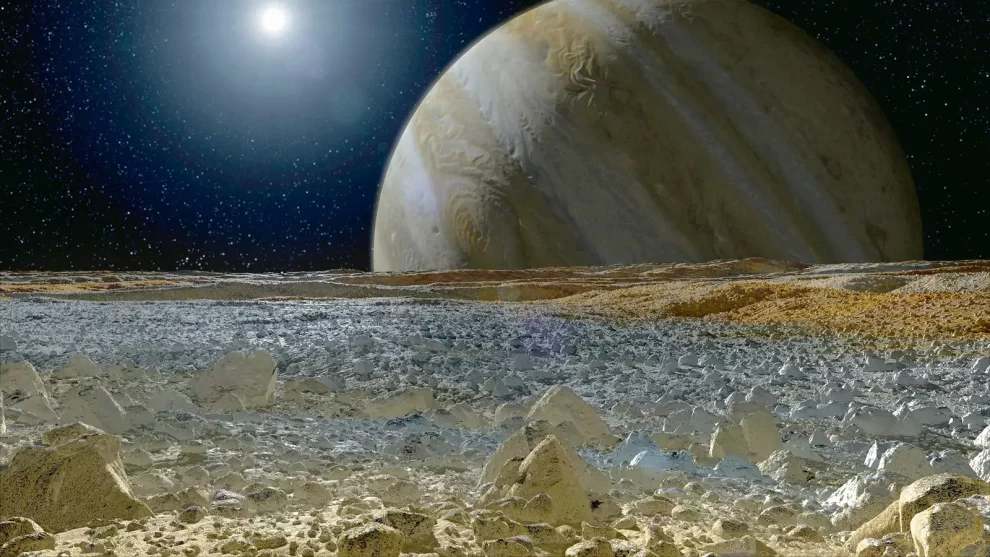Carbon an essential element for life on Earth might be lurking beneath the surface of Jupiter’s icy moon Europa, two new studies report, strengthening the moon’s place as a leading contender for hosting extraterrestrial life.
Though scientists had previously detected carbon dioxide on Europa’s surface, it remained unclear whether the carbon came from an external source, such as a meteorite, or from the ocean that lies beneath the moon’s icy shell. But now, the James Webb Space Telescope (JWST) has spotted carbon dioxide at a chaotic site on the moon’s surface, and the new analyses indicate it originated on Europa.
“This is a big deal, and I am very excited by it,” Christopher Glein, a geochemist at Southwest Research Institute and co-author of a new paper about the discovery, tells the Guardian’s Hannah Devlin. “We don’t know yet if life is actually present in Europa’s ocean. But this new finding adds evidence to the case that Europa’s ocean would be a good bet for hosting extant life. That environment looks tantalizing from the perspective of astrobiology.”
The high tech telescope’s observations were analyzed by two independent teams, both of which published papers in Science on Thursday. The researchers found carbon dioxide was most abundant within Tara Regio, an area of the moon with a geologically young surface called “chaos terrain.”
“It’s exactly what it sounds like. It’s chaotic,” Emily Martin, a planetary geologist at the Smithsonian’s National Air and Space Museum who was not involved in either new study, tells Scientific American’s Meghan Bartels. “What we think is happening, when it comes to chaos terrain, is that at some point, the surface got warm enough to break up into these little ice rafts—in some cases, large ice rafts—so that the entirety of Tara Regio is these broken-up puzzle pieces floating around in this now-solidified, icy, slushy matrix.”
In other words, the moon’s surface has been disrupted at Tara Regio, and scientists say that might have led to an exchange of material between the ice and the ocean below it, allowing carbon dioxide from the water to come to the surface.
Europa has long been considered an area of focus for extraterrestrial life. The 2,000-mile-wide moon is slightly smaller than Earth’s moon and covered with a 10- to 15-mile-thick coating of ice. Under that crust, evidence suggests Europa hosts a salty ocean that may stretch 40 to 100 miles deep, containing more than twice the volume of Earth’s oceans combined.
“For life, you need liquid water, the right chemistry, a source of energy and enough time for life to develop,” Andrew Coates, a physicist at University College London’s Mullard Space Science Laboratory who was not involved in the work, tells the Guardian. “We think all of those may be present on Europa.”
But any life on the Jovian moon would need to contend with some extreme conditions. Surface temperatures on Europa range between about minus 210 degrees Fahrenheit to minus 370 degrees Fahrenheit. And radiation from Jupiter is intense—a human astronaut would receive a lethal dose within just hours of landing on Europa.
One of the two teams also looked for evidence of plumes of water vapor erupting from the moon’s surface. The Hubble Space Telescope tentatively reported three detections of plumes in 2013, 2016, and 2017, though scientists have been unable to find definitive proof, per a statement from NASA. The recent JSWT data showed no evidence of plume activity, which NASA says allows the team to set an upper limit on the rate of material being ejected. Though this was a disappointing result to scientists, it doesn’t mean the plumes don’t occur.
“There is always a possibility that these plumes are variable and that you can only see them at certain times,” Heidi Hammel, of the Association of Universities for Research in Astronomy, says in the NASA statement. “All we can say with 100 percent confidence is that we did not detect a plume at Europa when we made these observations with Webb.”
Source: Smithsonian Magazine































